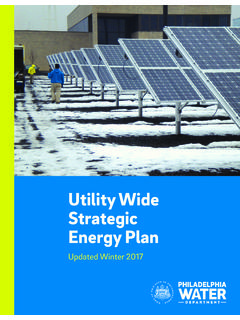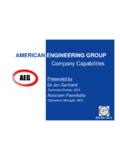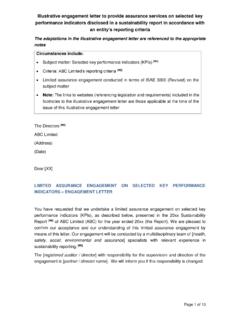Transcription of A TRNSYS Model of a Solar Thermal System with …
1 Session xxxxA TRNSYS Model of a Solar Thermal System withThermal storage and absorption CoolingMario Ortiz, Professor Andrea Mammoli and Professor Peter VorobieffMechanical Engineering DepartmentUniversity of New MexicoAbstractA combined flat plate and vacuum tube Solar Thermal array on the roof of the University of NewMexico Mechanical Engineering building is used to produce hot water. The hot water fires alithium bromide absorption chiller in the summer and flows through heating coils in the winter,providing cooling and heating respectively. To overcome problems associated with intermittentinsolation, an insulated concrete tank is used for hot Thermal storage . Additional concrete tankswithout insulation are used to store chilled water. These cold storage tanks are used as theprimary chilled water source to meet the cooling load, while the absorption chiller providesadditional cooling during peak load periods. The cold storage tanks are cooled by a district chillerat night when district chilled water demand and the cost of electricity are low.
2 TRNSYS , atransient systems simulation program with a modular structure, is used to Model and predictoptimal operating conditions of the Solar array working in combination with the Thermal storagesystem, absorption chiller and cooling System . This research enhances engineering education forundergraduate and graduate students at the University of New Mexico. Also, key concepts fromthis research are translated into standards-based middle school science response to concerns about sustainability, energy conservation, global warming, rising fuelprices and the current geopolitical climate, faculty and students in the Mechanical Engineering(ME) Department at the University of New Mexico (UNM) are taking steps to demonstratemethods which will result in drastic reductions in the carbon footprint of building overlooked, building operations total close to 40% of primary energy consumption in theUnited States and Europe1,2. Moreover, there is ample scope for reducing the energy consumptionin buildings due to the pervasiveness of wasteful practices and designs.
3 This paper is focused onoptimizing the operating parameters related to recent upgrades to the heating ventilation and airconditioning (HVAC) System in the UNM Mechanical Engineering building. These upgradesinclude the addition of flat plate Solar collectors, vacuum tube Solar collectors, an absorptionchiller, a heat exchanger and the refurbishment of some Thermal energy storage (TES) tanks. Theoptimized System will extract maximum useful cooling and heating from the Solar array anddeliver this energy to the building. A TRNSYS Model is used to optimize the System byevaluating its performance with varying operating parameters. By providing heating and coolingto the building from this renewable energy source, both the carbon footprint and operating costsof the Mechanical Engineering building will be ReviewProceedings of the 2008 ASEE Gulf-Southwest Annual ConferenceThe University of New Mexico - AlbuquerqueCopyrightc 2008, American Society for Engineering EducationPongtornkulpanichet a System installed in Thailand consisting of a 10 ton LiBr/H2 Oabsorption chiller, 72m2of vacuum tube Solar collectors, stratified Thermal storage (400 l of hotstorage and 200 l of cold storage ) and an auxiliary water heater.
4 The auxiliary water heater allowsthe absorption chiller to be the only source of chilled water (CHW) to cooling coils under allenvironmental conditions. The control strategy for this System is based on the Solar array outlettemperature. If the Solar array outlet temperature reaches 75 C, then the absorption chiller isturned on. When insolation is low, this System is operated at the lower threshold of recommendedabsorption chiller hot water inlet temperature. The auxiliary heater ensures hot water supply is atleast 70 C. The chiller is sized to cover 150% of the calculated maximum cooling load. Thisproject demonstrates the technical viability of absorption chillers. The project economics weredominated by the capital cost of the absorption chiller and the Solar collector array which, todate, are still very expensive. A conventional vapor compression cycle has lower capital costs thatcan be offset by the lower operating costs of an absorption chiller installation.
5 Advances inabsorption chiller technology and higher electricity prices would make Solar absorption chillersmore economically chillers and boilers off peak and storing hot or cold water in Thermal energy storage canproduce savings if the utility offers discounted off peak electrical rates. This practice also helpsthe utility to run efficiently by decreasing the difference between high and low demand the design and operation of the original UNM Mechanical Engineering buildingTES. He concludes that stratified Thermal energy storage can be achieved for typical HVAC applications without the use of partitions inside the tank. Stratification is accomplished by theuse of linear diffusers for both hot water inlet and cold water exit. For an approximately cubedshape tank, it is recommended that the diffusers have the same orientation where the hot diffuseris located at the top of one side of the tank and the cold diffuser is located at the bottom of theopposite side of the tank.
6 This arrangement avoids mixing by producing low velocity, uniformtemperature fluid flow in and out of the tank. The equipment that uses stored hot and coldstratified water must maintain the design temperature difference across storage inlet and outlet toavoid stratification degradation. This difference in inlet and outlet temperature must also bemaintained during tank charging. Constant inlet and outlet temperatures help to maintainstratification. A stratified tank can store more useful energy than a mixed and models of smaller systems led to the conclusion that an optimum volume ofa TES tank exists. A larger than optimal tank does not charge fast enough to reduce auxiliaryequipment use. A smaller than optimal tank loses capacity too quickly. For one System modeled,the optimum storage volume is defined as 75 kg of water per square meter of collector area5. Liand Sumathy6found similar results of decreasing System coefficient of performance (COP) with anincrease in tank volume.
7 Conversely, an undersized storage tank is described as not being able toeffect Solar cooling in the late afternoon. with the results of these computer models andexperiments in mind, storage tank volume can be considered an important design considerationregarding the reduction of grid peak electricity demand and Solar heating/ cooling chillers are a mature technology with a range of medium to large scale involves mechanical retention, as in the way that a sponge retains water7. In thisapplication absorption refers to a liquid acting like an absorbent sponge to absorb a refrigerant,Proceedings of the 2008 ASEE Gulf-Southwest Annual ConferenceThe University of New Mexico - AlbuquerqueCopyrightc 2008, American Society for Engineering Educationforming a liquid solution. This liquid solution is then pumped to a higher pressure. The highpressure solution is pumped into a generator that separates the solution into absorbent liquid andrefrigerant vapor. Analogous to a sponge being squeezed to force out the water that it hadabsorbed, the refrigerant vapor is separated from the absorbent liquid by adding heat.
8 Theabsorbent liquid goes back to the absorber to absorb more refrigerant and the refrigerant vapor ispassed through to the condenser. Heat leaves the refrigerant in the condenser to cooling waterbefore it goes through an expansion valve to an evaporator. In the evaporator heat is transferredto the refrigerant from water. Hence, CHW is produced. After that, the refrigerant is back whereit started and is ready to be absorbed by the liquid absorbent once ME building is located at the central campus of the University of New Mexico inAlbuquerque, New Mexico, where sunshine is abundant and cooling loads dominate for wellinsulated buildings. The ME building was built in the late 1970s to demonstrate energyconservation technologies. It is a 6,040m2, 5 story building with high insulation and high thermalmass. The building has air locks at all entrances to reduce heating and cooling loads caused byinfiltration during periods of high traffic. The window area of the building is relatively small at 5%of the floor area.
9 Further, there exist 8 concrete TES tanks with a useful volume of 1 shows the major components when the System is in cooling mode. CHW can beprovided to the cooling coils from cold storage and from the absorption chiller, separately or intandem. The flow rate of CHW from cold storage to the cooling coils is variable and can be setbased on the cooling load and amount of CHW supplied from the absorption preferred source of energy for meeting the cooling load is with CHW from the absorptionchiller. To produce CHW, hot water is drawn from the top of the hot storage tank to fire theabsorption chiller. The water is then returned to the bottom of the hot storage tank at a lowertemperature. Water from the bottom of the hot storage tank is pumped through the solarcollector array, heated and returned to the top of the hot storage tank. The outlet temperature ofthe Solar array water loop into the hot tank is maintained at a set temperature using a three waybypass valve.
10 The control System calculates the amount of heat that is added to the hot storagetank. When a set amount of heat is added to the hot storage tank, the absorption chiller isstarted. While the absorption chiller is running it supplies CHW to the cooling coils, reducing theflow rate of CHW from cold storage . As long as there is a set minimum amount of insolationhitting the Solar collectors, water continues to be pumped from the hot tank and through the solararray, adding more heat to the hot tank. The absorption chiller continues to run until theabsorption chiller hot water supply drops below a set temperature. At this point, the absorptionchiller is turned off and CHW from cold storage meets the entire cooling load while necessary. Thecold storage tanks will be charged by rejecting heat to a district CHW System via aplate-and-frame heat exchanger at nighttime when the university can take advantage of reducedoff peak electricity parameters available for optimization in cooling mode are Solar array exit temperature,temperature differential through the absorption chiller, Solar collector tilt angle, hot storage tankvolume, amount of heat collected in the hot tank before absorption chiller activation, absorptionProceedings of the 2008 ASEE Gulf-Southwest Annual ConferenceThe University of New Mexico - AlbuquerqueCopyrightc 2008, American Society for Engineering EducationFigure 1.










